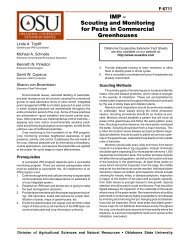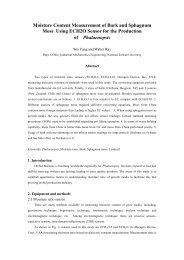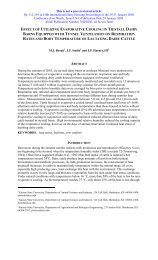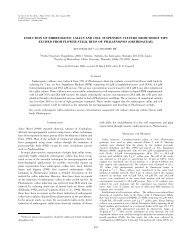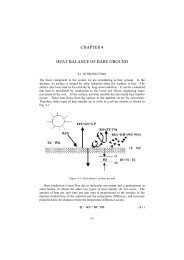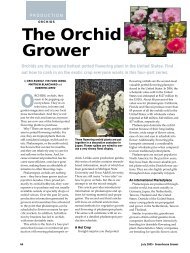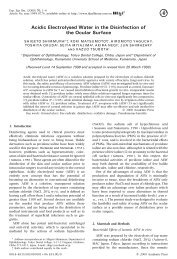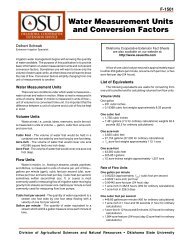Ventilation and Cooling
Ventilation and Cooling
Ventilation and Cooling
Create successful ePaper yourself
Turn your PDF publications into a flip-book with our unique Google optimized e-Paper software.
H E L P F U L H I N T SVENTILATING& COOLINGGREENHOUSESPUBLISHED BY:THE NATIONAL GREENHOUSEMANUFACTURERS ASSOCIATIONWhat is ventilation?<strong>Ventilation</strong> is the exchange of air between theinside <strong>and</strong> outside of the greenhouse. It is used toremove heat from solar radiation, to replenish carbondioxide <strong>and</strong> to help control the levels of relativehumidity.What is a ventilation rate?The ventilation rate refers to the amount of ventilationper unit area. It is measured as cubic feet ofair-per-minute per square foot of greenhouse floorarea (CFM per square foot) because the heat loadderives from solar radiation <strong>and</strong> is directly proportionalto floor area.What is the difference betweennatural <strong>and</strong> mechanicalventilation?Natural ventilation results from the wind <strong>and</strong> stackaction from ventilator sashes. Mechanical ventilationis created by electric fans <strong>and</strong> related equipment.What does cooling refer to?<strong>Cooling</strong> consists of reducing the air temperatureby the evaporation of water into the air-stream.The system that does this <strong>and</strong> moves the cooled airthrough the greenhouse <strong>and</strong> exhausts the warmedair is the cooling system.What is circulation?Circulation is the movement <strong>and</strong> mixing of air in agreenhouse to promote uniformity in temperature<strong>and</strong> humidity <strong>and</strong> to provide proper air motionthroughout the greenhouse.Why is circulation important tomy plants?Continuous circulation produces a gentle air movementwhich maintains a better leaf surface microclimate<strong>and</strong> prevents pockets of disease-producinghigh humidity.Why is ventilation important?<strong>Ventilation</strong> allows for the better control of temperature.By allowing an increase in light intensity,which is important to good plant growth, the solarheat can be more effectively removed.Why should I use exhaust fans?Exhaust fans are used to provide sufficient airflowthrough the greenhouse to remove solar heat asfast as it enters. Because the air is warmed graduallyas it passes through the house, absorbing heat,the flow rate should be sufficient both to hold thetemperature rise to a minimum <strong>and</strong> to be economicallypractical.How do I choose a system?The selection <strong>and</strong> arrangement of the ventilating<strong>and</strong> cooling equipment is determined by the size<strong>and</strong> type of greenhouse structure, the direction ofthe airflow through the house, <strong>and</strong> the velocityof the airflow through the house. Allowancesalso should be made for air density, light intensity<strong>and</strong> the permissible temperature variationthrough the house.How do I get the best results frommy system?For optimum performance, it is necessary to properlysize <strong>and</strong> arrange air inlet openings to producea uniformly distributed, non-turbulent airflow patternin the growing area to avoid the mixing of thelower air with the hot air in the upper section ofthe greenhouse. A definite airflow pattern in agiven direction requires an air inlet opening continuousfor the entire side or end of the greenhouse.The inlet opening should introduce the airin a horizontal direction at crop level, should notbe deflected up or down <strong>and</strong> should have a lowvelocity to minimize turbulence <strong>and</strong> mixing.I have a hobby-house greenhousedo I need ventilation <strong>and</strong> coolingsystem?Most small or hobby-house greenhouses are generallyaffected in the same manner <strong>and</strong> subjected tothe same conditions of cooling <strong>and</strong> ventilating thatapply to commercial greenhouses. Therefore, theprincipals <strong>and</strong> design recommendation listed forcommercial greenhouses are normally used. Forvery small greenhouses, however, package evaporativecoolers provide simpler installation <strong>and</strong>more convenient operation.Do I need to change my system inthe summer?During the summer, mechanical ventilation alonewill usually not maintain the desired greenhousetemperature because the outdoor air is too warm.Thus, a way for cooling the incoming air shouldbe provided.What happens to the cooled air asit moves through the house?As the cooled air moves through the house, itpicks up solar heat <strong>and</strong> increases in temperature bythe time it reaches the exhaust fans. This temperatureincrease is a result of the heat removal process<strong>and</strong> will vary depending on design. Increasing theairflow, or reducing the light intensity can reducethe temperature change. Increased fan capacitycan produce increased airflow; shading can reducelight intensity; <strong>and</strong> good maintenance can minimizethe infiltration of air leakage.Is elevation a factor in creatingventilation <strong>and</strong> cooling systems?The air’s capacity to remove heat depends on itsweight not its volume. Because air is less dense athigher altitudes, the elevation of the greenhousemust be considered in design calculations. Athigher elevations a greater volume of air is neededto provide the equivalent weight of air required atelevations that have been established as normal.
How many fans are needed <strong>and</strong>what do I need to know beforehaving them installed?The size of fans selected determines the numberof fans required. Adequate fans should be usedto provide a spacing of not more than 25 feetalong the exhaust side of the greenhouse. Whenpossible, the fans should be located on the downwindside of the greenhouse. When three orfewer fans are used in a given installation, one ofthem should be a two-speed fan to provide formore flexibility of ventilation. Fans should beguarded properly to prevent workers or animalsfrom coming in contact with any moving parts.For most reliable fan performance, only use fansthat have been tested <strong>and</strong> rated by the AirMovement <strong>and</strong> Control Association (AMCA)st<strong>and</strong>ard test code <strong>and</strong> which bear the AMCACertified Rating Seal.Where should the cooling padbe placed?The cooling pad should be continuous along theentire side or end of the greenhouse. Pad height isdetermined by dividing the total pad area by thelength. Pads should be confined <strong>and</strong> secured in away that provides uniform airflow, prevents sagging,avoids puncturing holes or large openings inthem <strong>and</strong> promotes uniform water flow throughthe entire length of the pads. The pads should beinstalled for ease of removal <strong>and</strong> withst<strong>and</strong> normalh<strong>and</strong>ling <strong>and</strong> usage. Whenever possible, the airinlet should be constructed in such a way that itcan be readily opened <strong>and</strong> closed without removingthe pads. It is preferable to have the padassembly located inside the air inlet opening; thiswill produce less turbulent airflow through thehouse. For such an arrangement the air inlet openingneed not be continuous but should be at leastwell distributed.What if the pad is located outsidethe air inlet opening?If the pad is located outside the air inlet opening, itshould be continuous, have no large obstructions<strong>and</strong> should be centered in elevation on the centerof the pad so that the airflow is horizontal as itleaves the opening. When the height of the padexceeds that of the air inlet opening, the pad willextend above <strong>and</strong>/or below the opening. Whenthis occurs, the pad should be set back from thewall or sash at a distance of at least half theamount of the extension to provide ample room forair to pass uniformly through the entire pad. Ifpossible the pads should be located on the prevailingwind side of the greenhouse. When the greenhouseis sheltered from prevailing winds by anotherbuilding or greenhouse located within 25 feet,the location of the pads in relation to prevailingwinds is not significant.How <strong>and</strong> why should I use baffles?The cooling air passing through the house willtend to diverge at about a 7-degree-angle or onefoot in every eight. Vertical baffles usually areinstalled particularly with the house, to reducemixing <strong>and</strong> keep cool air down at plant level. Thebaffles should be transparent, spaced approximately30 feet <strong>and</strong> held in a fixed vertical plane, <strong>and</strong>their lower edges should be well above plant level.In greenhouses containing raised benches, a substantialvolume of air may travel under the benchesto the fan without removing much heat. A bafflecovering two-thirds of the distance from the benchto the ground will force most of the cooling air tocrop level for more effective plant cooling.How do I maintain my water system?All elements of the water system should be keptwell covered, to protect it from insects <strong>and</strong> windborndirt, which will ultimately cause clogging.The water returned to the sump should bescreened. The ends of the water distribution pipesshould be provided with removable caps or valvesto allow easy flushing out for cleaning. Becausewater is used up in the evaporative cooling process,a supply of makeup water is needed. An automaticfloat valve should be used for this purpose <strong>and</strong> alsoto maintain a proper water level in the sump.Are winter <strong>and</strong> summer ventilationsystems the same?Essentially winter <strong>and</strong> summer ventilation systemsare two separate systems having different characteristics<strong>and</strong> requirements. However, they must tie inwith each other to switch from one system to theother during spring <strong>and</strong> fall. The transition is veryimportant as it determines the inside to outside temperaturedifference available on a mild, sunny day,<strong>and</strong> it establishes the airflow design capacity of thewinter ventilation system.Do I need to ventilate differentlyin the winter?Mechanical ventilation essentially provides thesame benefits regardless of the season, but wintercalls for different airflow principals. In the winter,outdoor air is too cold to introduce directly on theplants. The goal of winter ventilation is to introducethe cold air in a turbulent manner. This causesthe cold air to mix with the warmer air in the greenhouse,without producing cold drafts at plant level.This mixing is the result of using small high-velocityjets. In a greenhouse it is desirable to have manysmall, well-distributed openings rather than onelarge one for winter ventilation. It is important thatall areas of the greenhouse are at the same temperature.To achieve this, the ventilating system mustdistribute the air uniformly throughout the house<strong>and</strong> maintain positive air movement <strong>and</strong> continuouscirculation.Can I use gravity to circulate theair in my greenhouse?A powered ventilating system has a real advantageover gravity systems that rely on thermal air currentsbecause it has the energy required to provideuniform air distribution <strong>and</strong> mixing. Fans thatmechanically ventilate greenhouses, combinedwith perforated transparent plastic tubes, make anideal system for introducing cold air into a greenhousein the winter without cold drafts.What do I use thermostats for inmy greenhouse?Thermostats or controllers are used to turn fanson <strong>and</strong> off as required to meet changes in outdoorclimate conditions <strong>and</strong> thereby maintain moreuniform greenhouse temperatures with loweroperation costs.What do I use a humidistat for?During warm weather a Humidistat can be used tocontrol the pump of the cooling pad system to helpprevent excessive greenhouse humidity. A humidistatthat is wired to operate exhaust fans also canhelp prevent excessive humidity.How can I find out more aboutventilation?You can find out more about ventilating <strong>and</strong>cooling greenhouses by contacting the NGMAfor a free copy of the ventilation guidelines ordownload it from the web: www.NGMA.comVISIT US ON THE WEB:WWW.NGMA.C OM20 W. Dry Creek Circle, Suite 110Littleton, CO 80120800-792-NGMA (6462)303-798-1338 • FAX 303-798-1315



